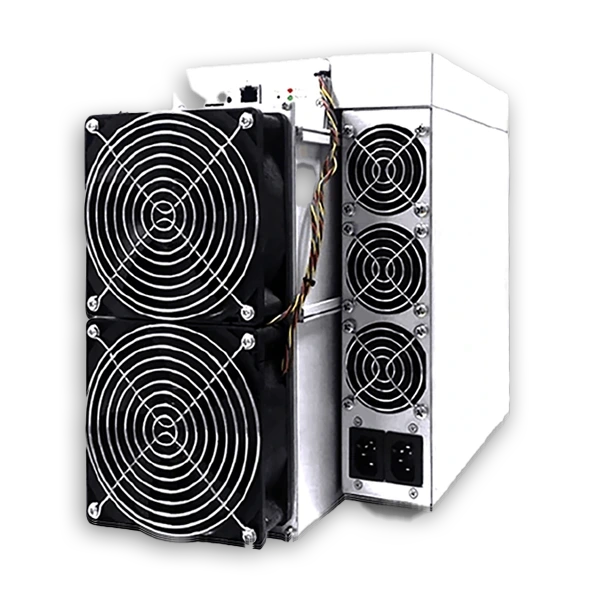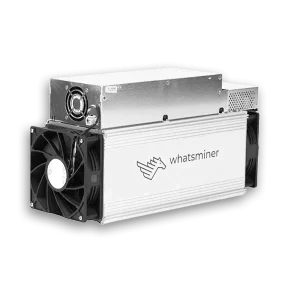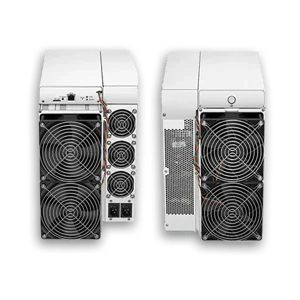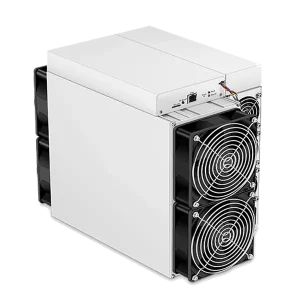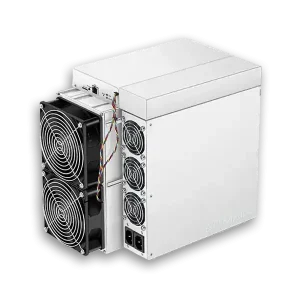Description
“Bitmain Antminer S17E 64Th Bitcoin Miner”: The Powerhouse Evolution in Bitcoin Mining
Released in 2019, the “Bitmain Antminer S17E 64Th Bitcoin Miner” marked a significant step forward in Bitcoin mining technology. Building upon the legacy of its predecessors, this model incorporated crucial upgrades to enhance efficiency, stability, and overall profitability for miners.
Upgrades from Predecessor Models
The “Bitmain Antminer S17E 64Th Bitcoin Miner” represented a notable evolution from earlier Antminer models, particularly the S15 and S17 series. Bitmain focused on addressing some of the reliability issues that had plagued previous generations while simultaneously boosting performance. Key upgrades included:
Enhanced Cooling System: One of the most significant improvements was the redesigned cooling architecture. The “Bitmain Antminer S17E 64Th Bitcoin Miner” featured more robust heat sinks and optimized fan placement. This enhanced heat dissipation was crucial for maintaining stable operation at higher hash rates and extending the lifespan of the hardware. Overheating had been a concern with some earlier models, leading to downtime and reduced efficiency. The improved cooling in the “Bitmain Antminer S17E 64Th Bitcoin Miner” directly translated to more consistent performance and reduced the risk of hardware failure.
Improved Chip Design: The “Bitmain Antminer S17E 64Th Bitcoin Miner” incorporated a new generation of Bitmain’s Application-Specific Integrated Circuit (ASIC) chips. These chips were engineered for greater energy efficiency and higher hash rates compared to the chips used in previous models. This advancement allowed the “Bitmain Antminer S17E 64Th Bitcoin Miner” to deliver significantly more processing power while consuming a relatively manageable amount of electricity. The increased efficiency was a key factor in the profitability of Bitcoin mining.
More Stable Power Supply: The power supply unit (PSU) in the “Bitmain Antminer S17E 64Th Bitcoin Miner” was also refined for improved stability and reliability. A stable power supply is essential for continuous mining operations, and any fluctuations or failures can lead to significant losses. The enhancements in the PSU of the “Bitmain Antminer S17E 64Th Bitcoin Miner” contributed to a more dependable and consistent mining experience.
Optimized Firmware: Bitmain also released optimized firmware for the “Bitmain Antminer S17E 64Th Bitcoin Miner” that further enhanced its performance and stability. Firmware updates often include improvements to power management, error handling, and overall system efficiency. This software optimization played a crucial role in maximizing the potential of the underlying hardware.
Key Product Specifications and Their Importance to Bitcoin Mining
Understanding the specifications of a Bitcoin miner like the “Bitmain Antminer S17E 64Th Bitcoin Miner” is crucial for evaluating its performance and profitability. Here are the key specifications and why they matter:
Hash Rate: 64 TH/s (Terahashes per second): The hash rate is the primary measure of a miner’s processing power. It indicates how many calculations the miner can perform per second to solve the complex cryptographic puzzles required to validate Bitcoin transactions and mine new blocks. A higher hash rate means a greater probability of successfully mining Bitcoin and earning rewards. The “Bitmain Antminer S17E 64Th Bitcoin Miner”‘s 64 TH/s hash rate was a significant figure at the time of its release, placing it among the more powerful miners available. This high hash rate is directly linked to a miner’s potential revenue.
Power Consumption: 2880W (Watts): Power consumption refers to the amount of electricity the miner requires to operate. This is a critical factor in determining the profitability of mining, as electricity costs are a significant operational expense. Lower power consumption for a given hash rate translates to higher energy efficiency and lower operating costs. The “Bitmain Antminer S17E 64Th Bitcoin Miner”‘s power consumption of 2880W needs to be carefully considered in relation to electricity prices to assess profitability. More efficient miners can generate more Bitcoin for the same amount of electricity.
Power Efficiency: 45 J/TH (Joules per Terahash): Power efficiency is a measure of how much energy the miner consumes for every terahash of computing power it delivers. It is calculated by dividing the power consumption (in Watts) by the hash rate (in Terahashes per second). A lower J/TH value indicates better energy efficiency, meaning the miner can achieve a higher hash rate with less power. The “Bitmain Antminer S17E 64Th Bitcoin Miner”‘s power efficiency of 45 J/TH was a significant improvement over some earlier models, making it a more cost-effective option for miners with higher electricity costs. Efficient miners are crucial for long-term profitability and sustainability in Bitcoin mining.
Chip Type: BM1397: The chip type refers to the specific ASIC chips used in the miner. These chips are custom-designed for the SHA-256 algorithm used by Bitcoin. Newer chip designs generally offer improved performance and energy efficiency. The “Bitmain Antminer S17E 64Th Bitcoin Miner” utilized Bitmain’s BM1397 chips, which were an advancement at the time, contributing to its higher hash rate and efficiency compared to previous generations. The architecture and efficiency of the ASIC chips are fundamental to a miner’s overall performance.
Cooling: Air-cooled: The cooling system is essential for maintaining the optimal operating temperature of the miner. Overheating can lead to performance degradation, instability, and even hardware damage. The “Bitmain Antminer S17E 64Th Bitcoin Miner” employs an air-cooled system, typically involving high-speed fans and strategically designed heat sinks to dissipate heat generated by the ASIC chips. An effective cooling system is vital for the longevity and consistent performance of the miner.
Noise Level: ~75 dB: The noise level produced by the miner is an important consideration, especially for miners operating in residential areas or shared spaces. The high-speed fans required for cooling can generate significant noise. The “Bitmain Antminer S17E 64Th Bitcoin Miner”‘s noise level of approximately 75 dB is typical for high-performance ASIC miners and may require soundproofing measures in certain environments. Noise levels can impact the suitability of a miner for different deployment locations.
Operating Temperature: 0 – 40 °C: The operating temperature range specifies the environmental conditions under which the miner is designed to function optimally. Operating outside this range can lead to reduced performance or hardware damage. Maintaining the “Bitmain Antminer S17E 64Th Bitcoin Miner” within its recommended temperature range is crucial for its reliability and lifespan. Proper ventilation and climate control may be necessary to achieve this.
Dimensions: 298 x 178 x 296 mm: The physical dimensions of the miner are relevant for planning the mining setup, especially in large-scale operations where space can be a constraint. The size and form factor of the “Bitmain Antminer S17E 64Th Bitcoin Miner” need to be considered when designing mining rigs and infrastructure.
Weight: 11.5 kg: The weight of the miner is another factor to consider for setup and transportation, particularly for larger mining farms. The weight of the “Bitmain Antminer S17E 64Th Bitcoin Miner” is typical for miners in its class.
The Significance of These Specifications in Bitcoin Mining
Each of these specifications plays a critical role in the overall performance, profitability, and operational considerations of using a miner like the “Bitmain Antminer S17E 64Th Bitcoin Miner” for Bitcoin mining:
A high hash rate directly translates to a greater share of the network’s processing power, increasing the likelihood of solving blocks and earning Bitcoin rewards. However, a higher hash rate often comes with increased power consumption, necessitating a careful balance between performance and energy costs.
Power efficiency is paramount for profitability, especially in regions with higher electricity prices. Miners with better power efficiency can generate more Bitcoin for the same energy expenditure, leading to higher profit margins.
The chip technology employed directly impacts both the hash rate and power efficiency. Advancements in ASIC chip design are the driving force behind the continuous improvements in Bitcoin mining hardware.
A robust cooling system is essential for maintaining stable operation and preventing downtime due to overheating. Effective cooling contributes to the longevity of the hardware and ensures consistent performance.
Noise levels can be a significant factor depending on the mining environment. Miners operating in residential areas need to consider noise mitigation strategies.
Operating temperature requirements dictate the environmental conditions needed for optimal performance and longevity of the miner. Proper climate control is often necessary in mining facilities.
Physical dimensions and weight influence the design and scalability of mining operations, particularly when deploying large numbers of miners.
